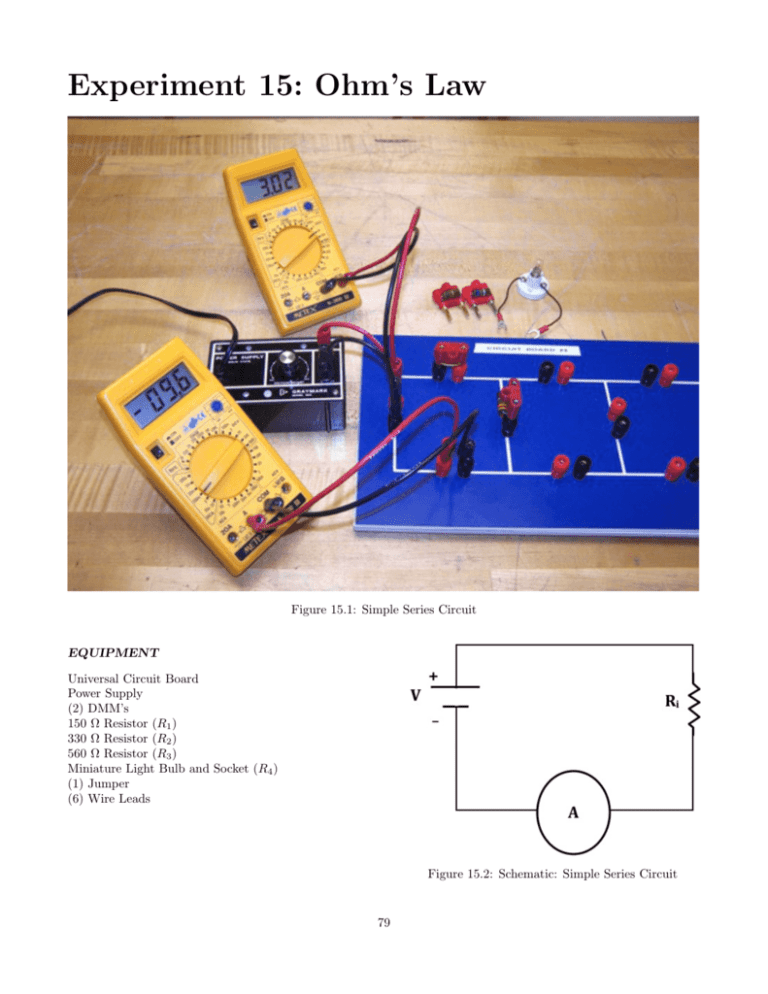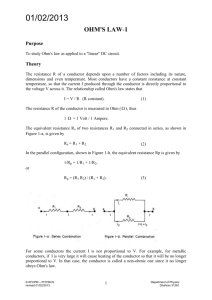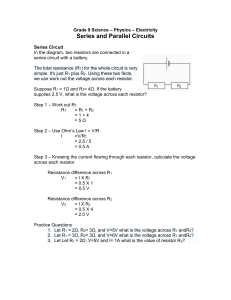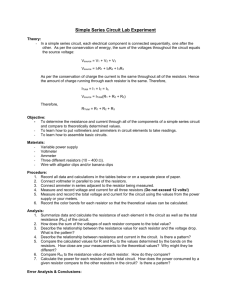
Experiment 15: Ohm’s Law
Figure 15.1: Simple Series Circuit
EQUIPMENT
Universal Circuit Board
Power Supply
(2) DMM’s
150 ⌦ Resistor (R1 )
330 ⌦ Resistor (R2 )
560 ⌦ Resistor (R3 )
Miniature Light Bulb and Socket (R4 )
(1) Jumper
(6) Wire Leads
Figure 15.2: Schematic: Simple Series Circuit
79
Experiment 15: Ohm’s Law
80
Advance Reading
Text: Ohm’s Law, voltage, resistance, current.
Lab Manual: Appendix B, Appendix C - DMM
Objective
The objective of this lab is to determine the resistance
of several resistors by applying Ohm’s Law. Students
will also be introduced to the resistor color code and
refresh their graphing skills.
Theory
Ohm’s Law states that the current, I, that flows in a
circuit is directly proportional to the voltage, V , across
the circuit and inversely proportional to the resistance,
R, of the circuit:
V
I=
(15.1)
R
In this experiment, the current flowing through a resistor will be measured as the voltage across the resistor
is varied. From the graph of this data, the resistance is
determined for Ohmic resistors (Ri , i = 1, 2, 3). NonOhmic resistors (R4 , light bulb) do not obey Ohm’s
Law.
Ammeters are connected in series so that the current flows through them. The ideal ammeter has a resistance of zero so that it has no e↵ect on the circuit.
Real ammeters have some internal resistance.
Voltmeters are connected in parallel to resistive
elements in the circuit so that they measure the potential di↵erence across (on each side of) the element.
The ideal voltmeter has infinite internal resistance.
Our voltmeters have approximately 10 M⌦ (10⇥106 ⌦)
internal resistance so that only a minuscule amount of
current can flow through the voltmeter. This keeps the
voltmeter from becoming a significant path for current
around the element being measured.
Resistors are labeled with color-coded bands that indicate resistance and tolerance. The first two color bands
give the first two digits of the value (Fig. 15.3). The
third band gives the multiplier for the first two, in powers of 10. The last band is the tolerance (Fig. 15.3),
meaning the true value should be ±x% of the color
code value. Refer to Table 15.1 for standard color values.
There is no need to memorize the color codes for lab.
For example, a resistor that has two red bands and a
black multiplier band has a resistance of 22 ⌦.
Figure 15.3: Color Code Schematic
Color
Number
Multiplier
Black
0
100
Brown
1
101
Red
2
102
Orange
3
103
Yellow
4
104
Green
5
105
Blue
6
106
Violet
7
107
Grey
8
108
White
9
109
Tolerance
Gold
5%
Silver
10%
(No Band)
20%
Table 15.1: Resistor Color Code Values
Prelab 15: Ohm’s Law
81
Name:
1. Write the equation and a qualitative statement for Ohm’s Law. (20 pts)
2. What are “ohmic” and “non-ohmic” devices? (20 pts)
3. Complete the following statement: An ideal ammeter has an internal resistance of
ideal voltmeter has an internal resistance of
, while an
. Explain why these are desirable attributes for
the respective measuring instruments. (20 pts)
4. If I vs. V is plotted, what value is obtained from the slope? Note that we are investigating the function I = V /R
and fitting our data to the slope-intercept equation of a line. (40 pts)
Experiment 15: Ohm’s Law
82
PROCEDURE
PART 1: Measures of Resistance
1. Determine the nominal resistance for the three resistors: interpret the color codes according to the
color code chart in Table 15.1.
2. Measure the actual resistance, R, of the three resistors using the ohmmeter and record them in the
table provided.
3. An ideal ammeter has no resistance; this ammeter
does have a small resistance. Measure the resistance
of the ammeter (200 mA DCA).
PART 2: Ohm’s Law Applied
4. Build a simple series circuit using R1 , an ohmmeter,
an ammeter, and a jumper (This will look similar
to Fig. 15.1, but without the power supply).
5. Measure the equivalent resistance of the circuit using the ohmmeter and record this value in the table
provided. Include units and uncertainty.
Figure 15.4: Spade Connection to Circuit Board
PART 4: Graphing
6. Remove the ohmmeter and connect the unplugged
power supply to the circuit. Connect a voltmeter to
the circuit, across the power supply leads (in parallel).
13. Open Graphical Analysis. Enter all of your voltage
and current data as four separate data sets (one for
each resistor). Include the point (0,0) in each set.
[Other graphing software may be used, provided the
graphs include all requisite elements.]
7. Have your TA check your circuit. Plug in the power
supply and turn it on.
14. Plot I vs. V for the three Ohmic resistors on one
graph. Apply a linear fit to each one.
8. Test Ohm’s Law (V = IR) by verifying that the
current increases linearly with applied voltage. Apply 1 V, 2 V, 3 V, and 4 V to the circuit. Measure
current and voltage and record them in the table
provided. Include units and uncertainty.
15. Calculate the resistance of each circuit using the
slope of your I vs. V graphs. Compare these Rgraph
values to the measured Req values using the percent
di↵erence formula (Eq. A.2, Page 155).
9. Repeat the Part 2 procedure for R2 and R3 .
16. Plot a separate I vs. V graph for the light bulb.
17. Print a copy of both graphs.
PART 3: Non-Ohmic Device
10. Build a series circuit using R4 , the light bulb
(Fig. 15.4).
11. Measure the current and voltage as you increase the
applied voltage in 0.2 V increments up to 2.0 V,
then continue in 1.0 V increments up to 4.0 V. Adjust the voltmeter scale to obtain the most significant figures possible.
12. Turn o↵ and unplug the power supply; turn o↵ the
DMM’s.
Experiment 15: Ohm’s Law
83
QUESTIONS
1. Read the information in the next column. How
much current would it take to cause pain? What
was the maximum current you measured for this
experiment?
2. Why was there no danger to you while you performed this experiment? The current required for
this experiment is as high as 30 mA. Some experiments will require current as high as 5.0 A. Explain
why there will be no danger to you. Read the information in the next column again, more carefully
if necessary.
3. Is the graph of I vs. V for the light bulb linear?
What does this tell you about the resistance of a
light bulb as the filament gets hotter?
4. Compare the experimental (DMM, graph) values for
each ohmic resistor.
5. Do the experimental values fall within the tolerance
of the resistors? What might cause the values to exceed the tolerance?
6. The power output of a circuit is given by:
P = I 2R =
V2
= IV
R
(15.2)
The resistors used in this experiment are 2-watt
resistors. What is the maximum power output of
R1 when 9.0 V is applied across it (use your graph
value)?
7. Calculate the power output of each ohmic resistor
(use your graph value) when a potential of 7.00 V
is applied.
8. Verify, using only the units provided in Table 14.1,
that each part of Eq. 15.2 is equal to J/s. What is
the unit of power output?
1 Hewitt,
Can voltage kill you?
It’s actually current that kills. So why are “Hazardous
Voltage” signs so prevalent? Paul Hewitt1 explains it
very nicely:
Consider Ohm’s Law: V = IR. What is
the resistance of your skin? That depends
on the state of your skin: dry or wet. If
it’s wet, is it water or sweat? Sweat, of
course, contains salt; salt water is a good
conductor.
The resistance will be dramatically di↵erent for di↵erent situations! Very dry skin
has a resistance of about 500,000 ⌦, while
skin wet with salt water has a resistance
of about 100 ⌦. Once the voltage of a device and your skin’s resistance are known,
we can estimate the current that will flow
through your body.
Current
E↵ect
0.001 A
Can be felt
0.005 A
Is painful
0.010 A
Causes involuntary
muscle contractions (spasms)
0.015 A
Causes loss of muscle control
0.070 A
If through the heart, causes serious
disruption; probably fatal if
current lasts for more than 1 second
Table 15.2: E↵ect of Electric Current on the Body
Note that the e↵ect caused by these currents are approximate values. It is quite difficult to get volunteers
for this area of research!
Paul G., 2006. Conceptual Physics. Pearson Addison Wesley, San Francisco.









